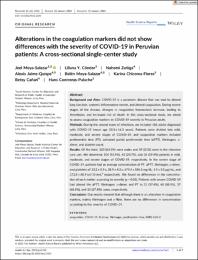| dc.description.abstract | Background and Aims:COVID‐19 is a pandemic disease that can lead to alteredlung function, systemic inflammatory events, and altered coagulation. During severestages of the disease, changes in coagulation homeostasis increase, leading tothrombosis, and increased risk of death. In this cross‐sectional study, we aimedto assess coagulation markers by COVID‐19 severity in Peruvian adults.Methods:During the second wave of infections, we included 186 adults diagnosedwith COVID‐19 (mean age 53.3 ± 16.3 years). Patients were divided into mild,moderate, and severe stages of COVID‐19, and coagulation markers includedprothrombin time (PT), activated partial prothrombin time (aPTT), fibrinogen,D‐dimer, and platelet count.Results:Of the total, 120 (64.5%) were males and 39 (21%) were in the intensivecare unit. We determine 104 (55.9%), 43 (24.7%), and 36 (19.4%) patients in mild,moderate, and severe stages of COVID‐19, respectively. In the severe stage ofCOVID‐19, patients had an average concentration of PT, aPTT, fibrinogen,D‐dimer,and platelets of 13.2 ± 0.9 s, 28.9 ± 4.3 s, 679.4 ± 185.1 mg/dL, 1.9 ± 3.1 μg/mL, and272.8 ± 88.9 cel/10 mm,3respectively. We found no differences in the concentra-tion of each marker according to severity (p< 0.05). Patients with severe COVID‐19had altered the aPTT, fibrinogen,D‐dimer, and PT in 31 (57.4%), 48 (88.9%), 37(68.5%), and 15 (27.8%) cases, respectively.Conclusions:Our results showed that although there is an alteration in coagulationmarkers, mainly fibrinogen andD‐fiber, there are no differences in concentrationaccording to the severity of COVID‐19 | es_PE |


